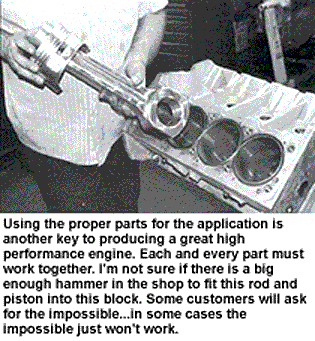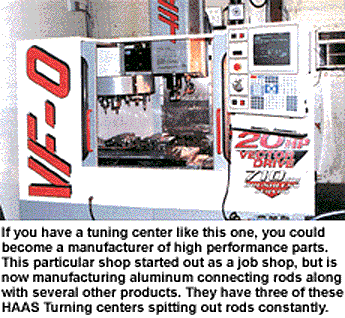As an automotive machine shop owner, you’re reading Automotive Rebuilder magazine because you want to stay abreast of all the happenings in your industry. Along with that, you’re also searching for ways to improve your bottom line by adding additional products or services to your operation. High performance machining could be the ticket.
The explosive growth of motorsports in the last five years has created tremendous opportunities for many shops and suppliers in the performance market. As an automotive machine shop owner, you may already have the equipment and employees needed to expand into this market; in fact, you may already be involved in it. "Fast Lane" is a new column that will help you find your way forward.
In 2001, we will take you to some of the top high performance shops in the country where we will show you how to do high performance machining in a variety of areas. Some of these shops do complete motor building, others specialize in just one or two areas, still others manufacture parts.
Also along the way, we’ll ask for your input and questions. "Fast Lane" is here for you. You have questions, and we want to answer them for you, but you need to let us know your wants and needs.
The last decade has seen phenomenal growth in motorsports. Shops and suppliers that have what competitors want have all the work they can handle, and backlogs of three to six months are not uncommon. Those shops specializing in just one or two areas generally have the longest backlogs, particularly if they are very good. Some of the more specialized shops will tell customers to wait a year.
There’s one point I want to make clear right now – don’t expect to just jump right into performance work. One of the keys to success in this business is to be good at what you do. "Word of mouth" at the racetrack will be your best advertising. Winning is another key. A racer who has problems with your products or services will let everyone else know.

If you are doing any performance work now, unless you have been doing it for awhile and have become very good at it, take your time and learn to do things the right way. The worst thing you can do is put a motor or part on the market and have problems with it.
Start out slowly, work with one or two racers, maybe even do work for free or at a good discount. Better yet, I’ll bet you have at least one employee who is involved in racing of one form or another – work with him or her. In such a case, you may already be doing performance work and not even know it.
Get out to the local track, talk to the racers and find out their needs. Who knows, you may be able to find a niche market right in your own backyard. I will warn you, however, if you do begin to do quite a bit of performance work, expect to spend a lot of time with your customers at their events. Visibility is another key to being successful in the high performance business. The most successful shops spend a lot oftime at the track.
If you’ve never ventured into performance work, you’re probably wondering how to get started. In addition to the tips listed above, you need to take a close look at your own operation. Ask yourself what are you really good at now? Would that area of expertise lend itself to high performance work, too?
Take an inventory of your equipment. Do you have machinery that could also handle high performance machining? If you have any CNC machines, you could become a parts manufacturer.
I know of one individual who was a machinist for a local job shop. He was also a boat racer. When he needed a new set of rods for his boat and was told it would be three to four months before he could get them, he made his own. He now owns his own machine shop that has three Haas turning centers that are in constant operation spitting out rods of all types. This business has also expanded into other areas such as manufacturing oil pumps and drives.
Another shop I am familiar with started in the early ’80s as a general automotive machine shop handling work for local garages and dealers. A few years later the owners began doing work for several racers and tractor pullers. More than 60% of their work now is high performance, and that percentage is increasing daily.
Chances are that whatever type of automotive machine work you are currently doing, you can merge into high performance work fairly easily. You probably already have the equipment and qualified machinists, you just need to learn the high performance business.
Finding help with the knowledge to do high performance work should be easy – just don’t expect your buddy who does high performance work across town to share all of his knowledge with you. Many shops that have already earned their wings will be hesitant to share their "secrets." Of course if that buddy is really good, he probably has more work than he can handle, and he may be willing to farm some of the work out to you.
Another good place for information is the manufacturers of the equipment you have in your shop. They will have all kinds of knowledge that they’ll be happy to share with you.
Another good source is your suppliers. Many of them maintain qualified people who are just a phone call away. They also may have extensive video libraries. Your parts suppliers will also have good information for you if they are involved in manufacturing performance parts, including piston and rod makers, ring and bearing manufacturers, etc.
Perhaps one of the best sources and a recent trend, is the growth of technical schools that are offering training in motorsports and high performance. The growth of motorsports has certainly led to this trend. The Mondello Technical School in Paso Robles, CA, and Northwest College in Lima, OH, among other schools across the country, offer courses in high performance machining. Northwest College even owns its own racetrack.
Being successful in the motorsports industry is no different than any other business, and if you are successful with your current operations you can also be successful in this business. If you produce a quality product that competitors want and, most of all, gives them an advantage, you will have all the work you can handle.
Let me tell you one more unique thing about racers: racers "live" to race. It’s in their blood, and they will do whatever it takes to get to that next race. That includes buying whatever it takes, whether they can afford it or not. The most important thing to them is to get to that next event. As a result, many racers (read: most) will max out their credit cards or pile up a lot of IOUs during the season, then spend the off season paying them off.
Many of your customers will ask you for credit and as a business owner, you need to decide how you want to handle that aspect. It’s best to simply use your existing policies in regard to credit, billing and collecting. (You do have a policy on this, don’t you?) Treat high performance work like any other business transaction, and you should be fine.
You will find that most high performance customers are loyal customers and more likely to pay their bills than many of your typical customers. Notice that I said "most." Your high performance customers are coming to you, because you have something they want that gives them an edge over the competition; they won’t jeopardize that relationship.

And speaking of relationships with racers, you need to consider sponsorships. You probably already get dozens of requests each year from racers to sponsor them. Your decision on handling this aspect of the performance market is an individual choice and there is no generic answer. It all comes down to what you are trying to accomplish.
If you are introducing a new product or service to racers, you may want to consider a sponsorship deal with one or two particular racers. And keep in mind, you should always work with the proven winners, because in motorsports, everyone follows the leader. If a guy wins on Saturday night with the new "Super Widget" from ABC Machine Shop, you can expect everyone else to come banging on your door to purchase that "Super Widget" before the next race.
Then again, if you already have proven products, you may be better to opt for sponsoring a series or division instead of individual racers. Of course, you may also have a product that is so revolutionary, that it will make a middle of the pack racer into a winner. In that case, word will really travel fast and you should expect to burn a lot of midnight oil to keep up with demand.
Motorsports is a multi-billion dollar industry with no finish line in sight. Surveys show that the average racer will spend an average of $4,000 per season to compete, but that is a very conservative estimate. A racer will spend whatever it takes to win, putting the businesses that provide high performance services and parts in a very good position. We want to help you grab a piece of that pie.
Jim Walbolt, an experienced writer and photographer covering motorsports activities, is from Luckey, OH. E-mail Jim at [email protected].













